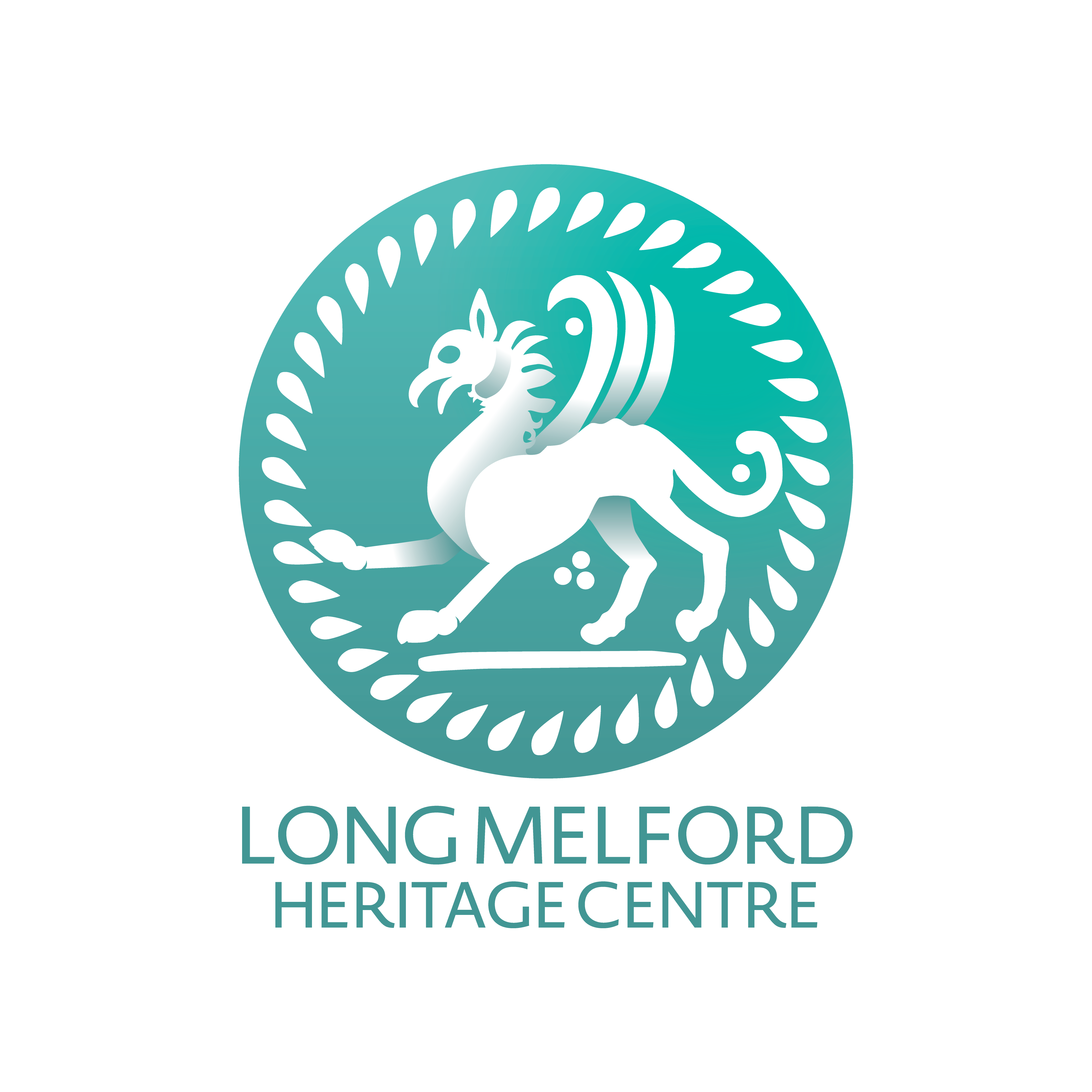This account of Long Melford Primary School is an attempt to show what it was like going to school in Melford during the late 1950s and early 1960s. It is chiefly based on reminiscences, both my own and those of other children who attended around the same time, along with some local and national social history to give the broader background and put our story into context. I’ve used names people were known by at the time, with further information available in the Acknowledgements section.
Memories like these are precious; if they are not recorded, as the years go by, they are lost forever.
My aim in writing this is the same as that set out by Ernest and Emily Ambrose in Melford Memories, written in 1972: ‘to write down some of these tales and present them in the form of memories and so preserve a record of days gone by (…) as conscientiously as possible, at the same time doing my best to avoid giving offence to living relatives.
I hope our little effort will serve to present a faithful picture of what life was like in a quiet corner of Suffolk before it was overtaken by the technological advances of the modern day.’
The world has moved on in the sixty years or so since we were at primary school; in the more than fifty years since these words were written; but our sentiments remain the same.
Sheila Cadge
Memories of Melford Old School
I attended Long Melford Controlled Voluntary Primary School between 1957 and 1963, and have many happy memories of my time there. It was a small Church of England village school, run from County Hall in Bury St Edmunds by West Suffolk Education Authority. John Hill was the Chief Education Officer at that time, and Robert Wickham Partridge was the headmaster. There were around thirty to thirty five pupils in each school year.
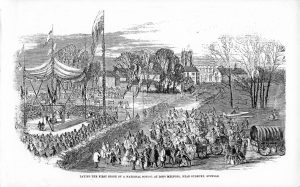
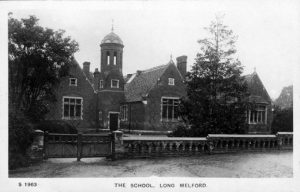
Circa 1912 Photo courtesy of Long Melford Historical and Archaeological Society (LMHAS)
I started school just before I turned five. My birthday was only a few days past the end of August cut-off date. I never went to St Catherine’s School (which was a building behind the church down St Catherine’s Road), which was at various times used for top class (early 1950s) and reception class, as the building was closed in our era and we all started at the top school. It only reopened when the numbers of baby boomers in the late fifties were too great for the top school to accommodate.
After the first day when my mum took me, I always walked to school with other children – It was very rare to see a parent collecting their children from school or dropping them off as you do today. You had to live more than a mile from school to be allowed to bike in, so it was a general practice that when you were little, older children took care of you walking to school, and you would repay the favour as you got older. (Having said that, once we moved to Cordell Road and my twin sisters, Pauline and Pamela, who were five years below me at school, started at St Catherine’s, which had re-opened by then, a group of children went down George Lane accompanied by a parent, as there wasn’t a lollipop man to help children cross the main road there.)
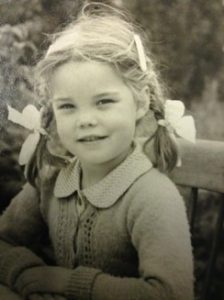
School photo time in Infants’ class
There was a lollipop man, Mr Ambrose, on the junction between the chemist’s and the Bull, to see children safely across, but no pedestrian crossings anywhere in Melford at that time.
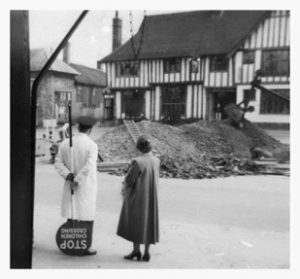
Ernie Ambrose the lollipop man observing the sewer scheme being installed in front of the Bull in 1958. (It would be a couple of years before flush toilets were installed at the school.) Photo and information courtesy of the Sandham Collection.
We walked to school in all weathers, come rain, snow or shine, and we used to take our time coming home. Favourite ways to waste time were at the Hall Mill bridge where we used to do twizzles (somersaults) over the railings, or go down the bank and play in the Chad, hopping across from dry bit to dry bit so we didn’t get wet feet and a telling-off when we arrived home. The grassed area was popular for practising somersaults and cartwheels. There were some snowberry bushes near there, and we used to collect the white berries when they were ripe, put them on the pavement and jump on them, they made a really satisfying ‘pop’. On the way home from school Maureen Lilley remembers going under the bridge to listen to the cars that went past over the bridge. (There weren’t that many in those days.)
Keith Slater remembers there were often convoys of military vehicles passing through Melford then, with the vehicle at the front bearing a red or blue flag while the one bringing up the rear had a green flag. The war had only finished a few years before so there was still a lot of military activity. The army vehicles could have been passing through Melford on their way to Thetford, possibly from Colchester. He also recalls collecting car registration numbers when he lived in Hall Street, along with his friend Robert Keeble, by writing them down in a notebook. They would then total up the number of cars that went by and see who had noted down the most. This must have been a reasonably popular pastime, as I used to go to Bull Corner to do the same with my friend Ardyn Smith. Prized registrations were single letters and numbers up to 20. (I did actually see the registration plate A1 in Melford a few years later, parked opposite Palmer’s shop.)
We made sure to hold our collar if we saw an ambulance, jump over cracks in the pavement, look out for black cats crossing the road and four-leafed clovers, enjoy the rainbows in puddles made by petrol after it had been raining, and jump on frozen puddles to break the ice. John Davies also remembers dawdling on the way home, doing somersaults and playing on the grassed area near Brook House, chariot racing along Hall Street holding onto each other’s coats and jumpers, searching for conkers in autumn to put on strings for conker fights, and soaking each other in the puddles. A less pleasant occupation was throwing strands of goosegrass (aka love hearts) at each other so that they stuck to your clothes, or getting the seeds out of rosehips in autumn and trying to put them down people’s backs, we called it itching powder. I enjoyed walking along the bank by the topiary in front of Melford Hall sometimes, I thought the shapes were really clever.
(We also used to do twizzles on the railings on the way up the Green next to where the elm trees used to be. They are sadly long gone, a victim of Dutch Elm disease, but apparently you can still see a dip under the railings where the ground has been worn down by generations of children’s feet.)
In winter we had snowball fights and made slides on the pond behind Hall Mill when it froze over. Pauline also stood on the ice on the Mill Pond and went through a few years later. She said Mrs Blunden, who lived at Hall Mill, kindly dried her black stockings on the radiator, and her Clark’s lace ups on the boiler as best she could until it was time to go home. (Her husband, Edmund Blunden, was a famous WW1 poet, and Professor of Poetry at Oxford at one point. My sisters were friendly with their youngest daughter, Cathy, and they remember playing cricket with Professor Blunden and Cathy.)
Keith’s recollection is that winters seemed harder than they are now and we would often slide our way to school on the frozen footpaths. The winter (the ‘big freeze’) of 1962-63 was extremely cold, with the first snow arriving before New Year. (We had gone to Granny Bugg’s at Bridge Street for our tea, as part of the round of festive visits in the Christmas holidays, when the snow started, and the little old black Austin 45, which belonged to Jeppy Mott from Bridge Street, (which was actually a very comfortable car to sit in, as it had a long front seat with a column change gear stick) that had taken us, got stuck in a blizzard halfway up Primrose Hill on the way back, so Dad had to walk back to Melford to find someone to come and rescue us. I remember waiting for what seemed like for ever with Mum and the twins and Jeppy, until we saw Dad trudging back through the snow, and then we all had to get out to transfer to the other vehicle over the top of the hill. The twins were carried as they were still little, but I have vivid memories of what a horrible experience it was walking up that hill). My sister Pauline, who was only five at the time, remembers getting chapped legs that winter as the snow was higher than her wellies whenever she went outside. The snow stayed more or less continuously for the next two months, but we managed to get to school nearly every day, although we were often freezing and soaked through when we got there.
Flooding was also quite common, more than once the Chad Brook burst its banks, and the main road was flooded, but we could still get to school over the little bridge behind Hall Mill where the ground was higher.
Once when I still lived at Little St Mary’s, and used to walk to school with Rita Palmer, it was a lovely spring afternoon, so we decided to pick some primroses for our mums on the way home. We went up Liston Lane and then turned towards Borley, getting as far as Liston Hall before we decided we ought to go back. We didn’t get home until well after 5 o’clock and our parents were frantic with worry, as can be imagined. I reckon we only saw two or three cars at most all the time we were out, and nobody to speak to at all! Very different from today.
Maureen can beat my story of coming home late: ‘One Sunday afternoon, my friend and I were bored, so we decided to climb up onto the school roof, through the clock tower, and into the school to raid the tuck shop. Unfortunately, we were seen. My friend’s sister met us off the school bus the next afternoon; it was our very first term at Sudbury Girls’ High School as we had left Melford School that summer. We were so afraid of Wickham Partridge and our parents that we ran all the way back into Sudbury (a mixture of fear and adrenaline!) and hid in the changing rooms of the old swimming pool at Belle Vue Park until past nine o’ clock. We had to write letters of apology to Mr Partridge and hand them to him personally and pay for the two chocolate bars.’
When we arrived at school, we hung our outdoor clothing on pegs in the cloakroom in the main corridor, or there was another cloakroom by the separate entrance to the classroom used by Mr Fox and Mr Danks. There was no school uniform when I went there, and outdoor clothing was rarely waterproof, duffel coats and gaberdine raincoats were a common option.
Girls mostly wore skirts and jumpers with woolly tights or knee-high socks, on top of vests, petticoats and fleecy bodices in winter, or frocks and cardigans with Startrite sandals and ankle socks in summer. Most boys wore short grey flannel trousers all year round, which came almost down to their knees, along with knee-high socks, which meant you saw a lot of chapped red knees when it was really cold. Sometimes you saw children with bright purple patches on their lips or rarves (scabs) on knees, as gentian violet was used to treat cold sores or as an antiseptic for grazes. It took a long while to wear off.
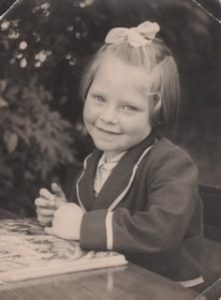
Maureen always wore a blazer for school photos:
Photo courtesy of Maureen Clayton (Lilley)
Staff
The Equal Pay Act for teachers came into force in 1961, but before that the female teachers at the school would have been paid significantly less than the male teachers for exactly the same job.
Several teaching staff had been working there for many years already, and had taught our parents.
(Although I don’t have pictures of all of the teachers from when I was a pupil at Melford School, I do have their autographs, thanks to a craze for autograph collecting when I was about nine.)
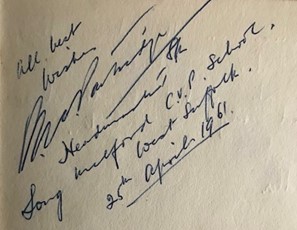
The headmaster was Mr Robert Wickham Partridge. According to John Davies, ‘He always came across as strict and authoritarian. I don’t remember him having a sense of humour at all (though he was chairman of the Long Melford Conservative Association!!) I am not sure if we all had to go to his office for reading and arithmetic tests from time to time or if I had to check on my progress having missed so much school through having rheumatic fever.
I never looked forward to the visits to his office which was located off the large classroom at the back of the school hall. Visitors, (including anyone about to be caned!), had to be shepherded into the office through this classroom. The office was small and rather untidy and dark. There were glass cabinets around the walls full of old papers and books and Mr Partridge’s desk was in front of the window that looked out onto a bit of a yard and the wall and windows of the other classrooms. There was a table with a green baize covering in the centre of the office that I can remember sitting at to do exercises and tests.
I can remember him talking to me about the Roman finds that were occurring in the village at this time c1958-1960 especially the Roman villa at the bottom of St Catherine’s Road and Liston Lane in Cutler’s field that was discovered by workmen digging the new sewerage system and gas main. Anything that was dug up that we managed to scrounge off the workmen and take into school was always claimed by him for safe keeping. (To my amazement I googled Roman Long Melford to check on the dates of all of this only to find Mr Partridge and Neville Byford from the Post Office both mentioned in an article Roman Long Melford by Norman Smedley (suffolkinstitute.pdfsrv.co.uk) from 10 Jan 2014 but originally written in 1961).’ (See Appendix A for more of John’s memories about the Roman finds at that time.)
Mr GO Chamberlin, the husband of our school secretary, Mrs Chamberlin, who played the piano in assemblies, had been headmaster before Mr Partridge. Mr Fox was Deputy Head.
The teachers who were responsible for infants were Mrs Morris, Mrs Forrester, Mrs Smith and Mrs Evans, and they took care of the youngest children.
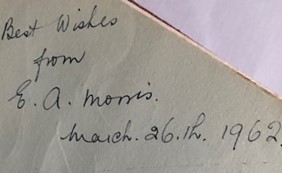
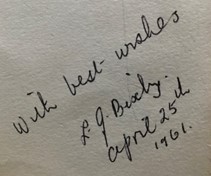
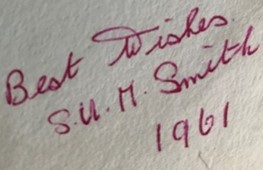
After Mrs Smith (whose initials were S.U.M. Smith, we thought it was hilarious they spelled SUMS) came Mrs Bixby and then Mrs Gooch, Mr Danks, and Mr Fox.
 Mr and Mrs Evans (he was a blacksmith). Photo courtesy of Long Melford Heritage Centre (originally In Suffolk Free Press)
Mr and Mrs Evans (he was a blacksmith). Photo courtesy of Long Melford Heritage Centre (originally In Suffolk Free Press)
Mrs Evans lived at Foxearth and came to school each day on a little white scooter. She was quite a tiny little lady and I remember her, and Mrs Forrester, as being really kind. David Underwood recalls the other staff worrying about her getting through flood water at Rodbridge on her moped, but she always turned up. Fiona Johnson has recollections of Mrs Evans reading to class one of The Famous Five books for story time.
I got invited to tea at Mrs Forrester’s once, and we drove there in her car as she lived outside Melford. What an adventure for me! Other children also remember invitations to tea from teachers lower down the school when they were in infants’ class.
Mrs Smith and Mrs Bixby were related, and both nearing retirement age when we were there. They were double in-laws. (In the family history section of the Long Melford Heritage Centre website, I found the following information about them: Granville Charles Miller Bixby married Lilian Josephine Smith (1899-1973), and Edward Stanley Smith married Sybil Ursula Miller Bixby (1901-1971).) A sister and a brother married a brother and a sister.
Mrs Smith always wore loads of face powder, and red lipstick, and she and Mrs Bixby were both very scary. Mrs Bixby had been a pupil teacher at Melford School, and taught Dad as well. She was very strict with a gruff voice and everybody was scared of her. Dad once gave me a bat in a jam jar to take to school to show her. He said it was for nature corner, but he knew she would be petrified (as she was – Dad thought it was hilarious when I told him – there was definitely an element of getting his own back there). Innocent me just did as I was told, and the bat was released unharmed afterwards.
John Davies saw a totally different side to Mrs Bixby: ‘She did have a gruff voice and demeanour but she was very kind and supportive to me personally, no doubt aided by being a fellow Church choir member alongside my sister Gillian! I had rheumatic fever aged five as did Kelvin Cracknell and my sister Gillian. Thankfully we all made complete recoveries but I missed a lot of school. I was in hospital in Bury for complete bed rest from August 1957 to January 1958 and had to learn to walk again as all my muscles had gone. For the rest of that school year, I was only allowed to go to school in the mornings and go home to rest in the afternoons. Very difficult aged five! On my return to school, they put me a year ahead of you all in Mrs Bixby’s class so that she could give me extra help to catch up which she did brilliantly. I had friends in that class too so I really enjoyed it and the extra attention. She always looked out for me subsequently.’
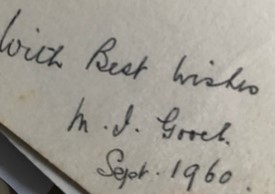
Mrs Gooch was tall and wore glasses, and she was slightly stooped and often had a bad cough. She was a good teacher; I learnt a huge amount from her. I had her for two separate years, Class 3 and again in top class, when most of that final year up until February was dedicated to preparation for the 11+ exam.
She used to come to school in an old black car, a model that still had running boards along the sides as I remember. (John has another anecdote about Mrs Gooch: ‘she lived in Borley of the most haunted house in England fame. One day a group of us went on our bikes to Borley ghost hunting and to try and scare ourselves. At one stage we plucked up courage to go into the dark and ghostly little church. As we crept in and walked down the aisle in near darkness late in the afternoon the organ suddenly started playing and terrified the life out of us. We ran from the church and stayed quaking outside until eventually Mrs Gooch emerged and explained that she was the church organist and had been playing just using the light above the organ!’)
My class teacher in Class 2 was Mr Danks.
I always found him quite distant, he died in 1963 by taking his own life. According to a report on 14th March in the Suffolk Free Press, following a complaint from a parent, Mr Partridge had interviewed him, and gone through what might happen next. That evening he committed suicide. His wife found him the next morning in the lounge, as they slept in separate bedrooms because they had a baby who was a bad sleeper. She smelt gas and saw her husband lying on the studio couch with his head near a turned-on gas tap. The coroner recorded a verdict that he died by carbon monoxide poisoning whilst the balance of his mind was disturbed.
Mr Jamieson (pronounced Jimmerson by everybody) came as his replacement for a while. He was the son of the chemistry teacher at the grammar school. I think Mr White started just after I left.
I was never taught by Mr Fox apart from on odd occasions, as I had Mrs Gooch for two years instead, in Class 3 and top class, but he used to produce a book with all his pupils compiled after visits to various places round the village.
They visited places of interest around the village including Holy Trinity Church to do brass rubbings, the fire station, Dr Barnardo’s Home and Adams’ Bakery, Kentwell Hall, Melford Hall, and the Maltings, Maureen remembered the visit to Stafford Allen, where the children learnt all about the carboys and their volumes, and she can still taste the liquorice root to this day. They also discovered information about topics such as indentures and the murder of Charles Drew. After each visit children wrote up their own account, complete with sketches and diagrams of what they had seen and heard. These were then marked and pasted into the book made especially for the purpose. Sadly, I never made this book, as I would love to have an album like that as a souvenir of my time at Melford School.
My cousin Jane Todd has memories of how Mr Fox always had his glasses on the end of his nose, and threw the books to your desk from his table instead of walking round the class room. Pat Brewster also remembers him as being very kind to her. She always had to sit at the front because of her deafness, and she sat with Jane Wall who was combing her hair while he was reading to the class, but they never got told off. Favourite lesson for Anne Howard was last lesson on Friday afternoon when Mr Fox would read Tom Sawyer & Huckleberry Finn out loud, chapter by chapter. Other children remember him reading out Wind in the Willows.
Student teachers: Everyone loved the term when the student teachers came as they were much younger and we thought they were a lot more fun and less strict than our normal teachers.
Children who came: In general, there was very little movement of pupils at that time, and families tended to stay in the same place their fathers and grandfathers had lived in. Because I come from two large Melford families (Cadges and Buggs, my parents had more than fifty first cousins between them), there would be at least one or two of my cousins in every class in the school. In my year there were Peter Cadge, who lived at Lyston House, and Cherie Cadge, who I was good friends with. Uncle Ernie and Aunt Frances ran the White Horse in Southgate Street and I would often go to see Cherie when we were visiting Dad’s aunts down there.
John can remember, as a twin himself, that it used to amaze him how, despite only being a small village school, when we were in the final year at the primary school there were sets of twins in every year through the school! Sets of twins whose surnames he recalls were Davies, Boggis, Cadge, Wicks, Beevis, Day, and Oakman.
There was also the Sacco family (Louis and Pasquale) from Naples who lived at Rodbridge in a house that has now been demolished (I’m not sure why they ended up in Melford, maybe their father had been at Borley, where there was a camp for Italian POWs); and a girl called Leslie Cockerill from Alaska whose father was stationed on a local USAF base, and unusually lived off-base, sending Leslie to an English school rather than one which followed the US school system. She stayed a year or so when she was about six or seven. I had a friend called Lynne who moved away in Mrs Bixby’s class, but usually even if people moved it tended to be to another house in the same village or a neighbouring village. A couple of local families emigrated to Australia on the £10 assisted passage scheme.
School dinners were cooked in a central kitchen and came in a van in big metal containers and trays. Friday lunch was always some kind of fish or cheese dish. There was a small kitchen at the side of the hall where the dinner ladies would dish up the food and wash up afterwards.
I thought they smelt and tasted disgusting, especially the stew and the watery mashed potatoes. I didn’t often have school dinners, I usually went home for dinner or had sandwiches. Pauline felt the same as me: ‘As for school lunches I only went very rarely and never enjoyed them apart from the chocolate crunch. I didn’t like the pink custard that was served with it. Apart from the awful smell, the tapioca frogspawn dessert or the watery greens what put me off most of all were the opaque- white water beakers which had teeth marks all round them, and the boys pretending to spit in the water jugs.’
John had a different opinion: ‘I liked school dinners, I can still remember my favourite dessert of pink custard and chocolate shortbread. I am not a fussy eater; however, my twin brother Brian was, and Mr Partridge would often stand over him at lunchtime and try and persuade him to eat his dinner. On one occasion he made him eat up his greens. My brother got his revenge by promptly being sick all over Mr Partridge’s clean shoes!’
There was a tuck shop in the hall at morning playtime, and some of the top class used to help serving the children. I rarely had any money to spend there. If I did, I would buy Oxo crisps, Potato Puffs or a Wagon Wheel. Mars Bars cost 4d, they were really expensive for us. Pauline remembers Mr Partridge buying a 2d bag of roasted salted peanuts, opening the end, and tipping them in his mouth all at once. We drank our third-of-a-pint bottles of milk there, which came in crates that were delivered to the cloakroom area at the front of the school. In winter the bottle tops were often a few inches above the bottles sitting on ice and we had to try and thaw out the milk on radiators or with our hands. Sometimes the blue tits pecked through the foil tops. Normally there was a box of 500 straws by the crates, but a couple of times we were given stripy paper straws for a treat. The red ones were strawberry flavour and the brown ones were chocolate, and when you swirled the straw around in the milk bottle it turned into milk shake.
We collected the foil bottle tops for charity, rather than discarding them, and also brought milk bottle tops from home to add to the collection.
Savings stamps Dinner money was five shillings for the week, and it was collected in on Monday morning by your class teacher. They also were in charge of selling National Savings stamps which either cost 6d (Princess Anne) or 2/6 (Prince Charles).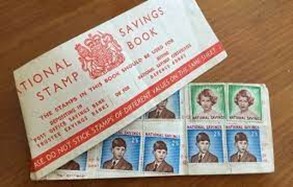
These had glue on the back, and everyone had a book to stick them in. Once the book was full it might get exchanged for savings certificates. Every couple of years or so, as the Royal children grew older, new stamps were issued. I found it interesting watching them growing up. Princess Anne was only two years older than our class, and Prince Charles was four years older.
Classrooms The building was a typical Victorian design, with windows so high you couldn’t look out in any of the class rooms, apart from Mrs Bixby’s where there were French windows leading onto the boys’ playground. The school was built in warm red brick in a mock-Elizabethan style to mirror Melford Hall which was directly opposite. There had previously been separate boys’ and girls’ entrances and schools, but classes were mixed when I went there. The whole school was decorated institutionally, painted with shiny green and cream heavy-duty paint.
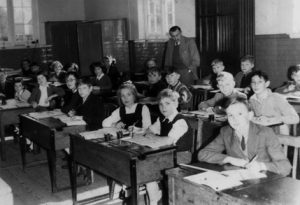
Bill Fox’s class 1953-4, possibly at St Catherine’s School: the classrooms still looked exactly the same when I went there. (Photo courtesy of the Sandham Collection)
The infant section was on the left side as you went in the main corridor, and that was less formal than the juniors, we sat round tables and had all kinds of equipment such as cowrie shells for learning numbers, adding and taking away, and slates for writing practice.
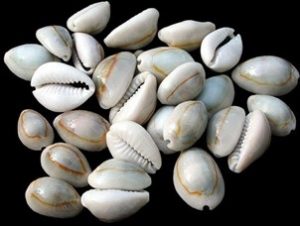
There was a sand pit in the corner, and a sink as well. Our reading books were quite old, I remember stories about Little Red Hen, Chicken Licken, Henny Penny, Cocky Locky and Brer Rabbit. My cousin who lived in Essex learnt to read with Janet and John, which looked a lot more modern than the vintage books we used, goodness knows how old they were. I’m not sure that much had changed since Dad was at school.
In the junior classrooms children sat in rows facing the teacher, in ancient oak double desks with built-in inkwells. The teaching method at that time was very much ‘talk and chalk’, with the teacher at the front of the class. The blackboard had a little shelf for the board rubber/duster and chalk. The felt in the board rubber would get totally clogged up with chalk, and I really enjoyed being allowed to go outside to clean it with a friend. We would either hit it with a ruler or bang it against the wall, creating clouds of chalk dust in the process.
Round the walls, as well as children’s work, there were a variety of posters produced by the oil company Shell (they all had a yellow shell emblem at the bottom of the poster). These could be rolled up and were regularly changed as there were posters for the different seasons, months of the year and counties, as well as many nature posters such as Shell Guide to Life by the Road or Life on the Tideline or Life on the Cliff. There was a nature corner in every classroom and we were encouraged to bring in things we found such as bird nests or shells. in early spring we put twigs from horse chestnut trees into a jam jar in water in the classroom window so we could watch the sticky buds turn into leaves.
There were coke stoves in the corner of the classroom surrounded by iron railings to keep us out, where we used to hang wet things to dry, so you can imagine how smelly and steamy it got in the classroom, especially in winter, as many children would only have a bath once a week, and sometimes would wear the same clothes all week. John also recalls that lower down the school those railings were often called into service to dry out clothing of pupils that had had ‘toilet’ accidents as well as to dry out hats and gloves from playground snowball fights. The stove got red hot and a favourite pastime was to flick drops of water or snow on it, or spit on it so we could watch the water exploding off (not when the teacher was looking obviously!). They were very effective at keeping us warm despite their antiquity.
School hall the school hall had three doors leading into it: one from the main school corridor, one from the cloakroom at the front of the school, and a double door leading into Mr Fox’s/Mr Danks’ classroom and Mr Partridge’s office. You had to go through it to get to Mr Partridge’s office from the main corridor if you didn’t want to go round the outside. We always faced the double door for assembly. Behind us over the door to the main corridor there was a clock. The hall was equipped with dark brown painted cupboards where items such as musical equipment were kept. There was a piano in the top right corner, which Mrs Chamberlin played on various occasions. Pauline remembers the neo-impressionist painting by Seurat of the Bathers at Asnières hanging in the hall. She said: ‘I could never get the concept, nothing about Impressionism was ever explained to us, and I just thought he wasn’t a very good artist!’ It would be decorated seasonally at various times throughout the year, such as Christmas, Easter and Harvest Festival.
It was in constant use throughout the day. It was just big enough to fit the whole school in it for assembly, when we would sit cross legged on the floor. It was where we went to get our milk at morning break and school lunches were served. The kitchen off to the side was used for serving meals, and long tables and chairs were stored there as well.
It was used for a variety of lessons such as music, country dancing, and PE. There wasn’t much in the way of gym equipment, but we did sometimes sit on little coloured oval sisal mats. The radio was here for Schools’ Radio broadcasts, and on very rare occasions a film projector and screen were set up.
Toilets When I first went to the top school there were no flush toilets, instead there was a block at the back of the girls’ playground – these were earth closets and very smelly – wooden boxes with some kind of trough underneath which was emptied regularly by the council, and it was a regular announcement at assembly for girls not to use too much (horrible hard Izal) toilet paper.
Keith remembers that the boys’ toilet had a black wall you peed up against with a trough below. As you went for a pee it was easy to see where you had made the black wall wet and the main object was peeing as high up the wall as you could, the pinnacle of success was to be able to pee over the top of the wall, which just a few managed and this would be met with cheering and applause. (Boys will be boys!)
The handbasins were just inside the school in one of the cloakrooms, and it was always freezing cold there even in summer. There was a bar of strong-smelling red Lifebuoy soap on each basin, with roller towels at the end of the row of handbasins. These were not very absorbent, and became wet all the way round by the end of the day.
When I was nine or ten a new block of flush toilets was built in the girls’ playground (causing great excitement all the time the builders were working there), and we had an official opening, where all the children from St Catherine’s School, including my sisters Pauline and Pamela, walked up to the top school for the occasion. The toilets were much less smelly obviously but I don’t remember them being any warmer, and you still had to venture outside when it was raining, although not quite so far. Pauline said the toilets at St Catherine’s were in a brick building, no more than a shed, with wooden doors. She thinks that the Elsan toilets were large green enamel tins, she was always scared of falling in. She can only remember the flush toilets in the main school building: ‘One drawback of the flush toilets was that older girls would think it was great fun to stand on the toilet, reach over into the next cubicle and pull the chain to flush the toilet of the unsuspecting occupant. There were also paper towels in my day supplied by Kimberley Clark. ‘
For some reason Annabel Blackwell and her friend (who cannot have been more than five or six years old at the time) decided to fill up one of the newly-installed girls’ toilets with builders’ sand left behind after construction. and really packed it down. She can’t remember her punishment but the school told her parents, who were angry at the time, but laughed about it for years afterwards.
Playgrounds the playgrounds were segregated, with the ‘big boys’ in the side nearer to the church and the youngest boys and all the girls in the side nearer to Hall Mill.
The girls tended to play more games such as doing handstands against the wall with skirts tucked into knickers, cat’s cradle, Statues, ‘What’s the Time, Mr Wolf?’, ‘The Farmer’s in His Den’ and ‘The Big Ship sails on the Alley Alley O’, skipping games, such as ‘I am a pretty little Dutch girl’, which had several verses, and counting out games such as:
Eena meena mackaracka
Ree rye dominacka
chickalicka lollapoppa
om pom push
Dip dip dip
my little ship
sails across the water
like a cup and saucer
You are not IT
There was a climbing apparatus in the corner nearest what had originally been the teacher’s house, but it wasn’t very exciting, the smallest children tended to use it. If you were playing any kind of game such as Tag where you wanted a rest you would cross your fingers and shout ‘exies’ and that gave you respite for a little while. (Where I live now children shout ‘skinch’ or ‘skinchies’.) We would all ask stupid questions such as ‘Are you a PLP?’ where there was no right answer. If you said yes, people would lean on you and say you were a public leaning post, and if you said no, they would laugh and say you weren’t a proper looking person.
(If you are interested in children’s customs and language, I thoroughly recommend Lore and Language of Schoolchildren by Peter and Iona Opie published 1959, hence very much about the era when I was at primary school and earlier. It is a wonderful book.)
One year there was a hula hoop craze, mine came from the local hardware shop and was yellow, I really envied one girl who had a flesh-coloured one, as you couldn’t buy those in Melford. Various crazes included autograph books, and swapping cards from sweet cigarettes or bubble gum packets, and PG Tips albums among other things. Another favourite activity was paper fortune tellers, a square of paper folded with colours or numbers as options for you to choose from, and eight flaps on the inside, each concealing a message. And of course, every year birthday bumps were given to the lucky birthday girl or boy.
In the run-up to Bonfire Night boys would use their pocket money and money collected from ‘Penny for the Guy’ to buy fireworks (Butcher’s the newsagent’s always had a good selection), and sometimes brought them to school; more than once bangers and jumping jacks were let off in the playground, although this was strictly forbidden. I was terrified of the jumping jacks as they always seemed to follow you, whichever way you ran.
There would be teachers on duty outside supervising, and Maureen recalls Mrs Gooch whilst on playground duty, constantly taking something out of her coat pocket and popping it into her mouth. She always wanted to know what they were but didn’t dare ask as Mrs Gooch was so scary: decades later the mystery has been solved, my sister Pauline used to be given the occasional extra strong mint. She would give Pauline one and tell her not to tell anyone, while coughing all the time. At the end of playtime, the whistle would blow and you had to stand in line and lead back to your classroom.
Wheat was grown in the field behind the girls’ playground, and in summer everything would be covered with tiny midges that came from the corn, they even got into picture frames. When the stubble was burned there would also be ash, but usually this took place in the summer holidays so it wasn’t a problem for the children playing.
I was really envious of the boys’ playground one winter when they made a super slippery slide outside Mrs Bixby’s class room which lasted for days because it was on the north side of the building. We would sneak on it at the end of school. Sadly, the caretaker Mr Honeyball came and put sand all over it – understandable as it was absolutely lethal, but we were so disappointed. A few years later, when Pauline was in the top class girls were allowed to go into the boys’ playground and play on the slides in winter, and the boys were even allowed to use a hose pipe to make the playground into a big slide if really cold weather was forecast.
In my last term at Melford, in June 1963, I recall that the playgrounds were abuzz with excitement for the boxing match between Henry Cooper (Our ‘Enery) and Cassius Clay (later known as Muhammed Ali). There was great excitement and pride when Henry succeeded in knocking him down followed by indignation after the fight about the length of the count out. Clay’s cocky personality was the opposite of Cooper’s, and Brits were rooting for Henry to teach him a lesson. Sadly, this never happened as both that fight and the re-match three years later were stopped after Cooper started bleeding excessively from a cut to the left eye.
Boys’ playground by John Davies ‘The playground backed on to School Lane and the school allotment plots and also housed the bicycle sheds. We spent a lot of time playing football with old tennis balls and even home-made balls made from anything we could lay our hands on. There were periods when football was banned because it was too much of a nuisance.
We often played cricket in the school playground. Wickets were chalked on the wall and a bat and ball produced and games would often involve a large number of friends. Hopscotch and tag games were also popular.
We all looked forward to winter (and there were some very cold winters in the early 1960s) when we could make slides across the ice in the playground and hurl ourselves about to see who could slide the furthest. We sometimes played marbles and skittles with items we had made ourselves.
A really popular playground pursuit in the last couple of years at break and lunchtimes was playing what we called Flicksies! This was still the era of cigarette and tea cards which we would all collect and exchange. The games took place against a wall – the favourite one being the brick wall at the end of the bike sheds near School Lane. There were three types of game all played from a kneeling position next to each other singly with a friend or in doubles with two in each team taking it in turns. Overs involved flicking the cigarette or tea cards towards the wall from about six feet back until one of the cards landed on top of another that had already been thrown. You had then won all the cards that were already on the ground. Unders involved having to get the card you were throwing under any of the cards already on the ground. Knocksies involved standing a single card upright against the wall and having to knock it over with the card you were throwing. New cards, which were still much stiffer, were much more effective than the older softer and bent cards. The objective was to win as many cards as possible from your opponent to add to your collection which was taken to school every day in old sweet or biscuit tins!
There were sometimes flare-ups or ‘fisticuffs’ in the boys’ playground when two boys would square up to each other and exchange blows. A ring of boys would quickly surround the two combatants and the chant of ‘fight! fight! fight!’ would ring around the playground. This, of course, would quickly bring a teacher to the scene who would break through the cordon of boys and separate the fighters. They would then be hauled off indoors. Lines or caning inevitably would follow depending on the seriousness of the altercation!’
(Pauline remembers an occasion where two boys did not get on with each other, and the animosity had rumbled on. The following strategy was adopted to sort the issue out once and for all: The two boys donned boxing gloves, and had a boxing match in the playground supervised by Mr Fox!)
Assemblies nearly always followed the same pattern unless there was a guest speaker. Mr Partridge would lead the assembly which would start with a hymn, with Mrs Chamberlin in the top right corner playing the piano. This was followed by some kind of talk, perhaps a Bible story or information about missionaries’ work or similar topics. Then we always recited the Lord’s Prayer and maybe one or two other prayers, followed by notices and announcements from Mr Partridge, including general tellings-off if necessary. Pauline can remember, a few years later, being hauled out of assembly by Mrs Partridge (who used to come in to teach at the school sometimes) for talking. She asked her why she was talking when they weren’t supposed to. She replied she wasn’t talking she was singing (making up nonsense songs about Carnation milk while Mrs. Chamberlin played the piano.) Mrs Partridge wasn’t best pleased with that reply.
Reverend Simpson used to come down and take services every so often, but when he retired in 1960, Melford didn’t have a rector for quite a long time until Reverend Herbert came in 1962. He had a much warmer personality than Reverend Simpson, who always seemed quite old and remote. We had hymn practice one morning a week after assembly. My favourite hymns were: We Plough the Fields and Scatter, and Morning has Broken. We would celebrate various festivals throughout the year including Easter, and Harvest Festival, where everyone would bring something from home, sometimes tinned food, but mostly vegetables and fruit from gardens and allotments, which was handed round to the older people in the village afterwards.
The ten shilling note by John Davies ‘My twin brother Brian and I often walked to school from St Catherine’s Road with our friend Melvyn Roscoe who lived opposite us and was a year older. One morning splashing our way through the many puddles on Hall Street on our way to school we discovered a sodden ten shilling note floating in a puddle outside Kemp’s TV and Radio shop. As budding upstanding citizens, we decided to hand it in at school and thought nothing more of it.
Several months later we were all in school assembly when two police officers arrived and Mr Partridge called out our three names to come to the front. Our hearts were in our mouths! What had we done wrong? Had someone seen us cutting down trees for our goalposts on our football field off Meeting Field Lane (on the field where they used to grow carrots, that is now a housing estate)? Or playing on haystacks in farmers’ fields or building dens in private woods?
The police had actually come to give us three shillings and fourpence each as no one had claimed the lost ten shilling note! The two policemen then gave us all a lecture about how honesty always pays!’
Discipline There were no classroom assistants when we were at Melford school, just the class teacher, and discipline was strict. The pupil teacher system was no longer being used. I was scared of most of the teachers, especially Mrs Smith and Mrs Bixby, who both seemed very fierce, so I never really needed telling off much. However, I got lines from Mrs Bixby on more than one occasion for turning round in class to chat to Ian Cameron. Maureen Lilley got those as well for turning around to chat to Jig Webb, and she was also given 100 lines by Mrs Gooch ‘I will not go outside to play without wearing my coat.’ Jane Todd went into the field with the pond next to School Lane with some friends, and got 100 lines for her sins, she ended up writing: ’There was a little girl who had a little curl right in the middle of her forehead…when she was good, she was very, very good, and when she was bad, she was horrid,’ during playtimes for days on end. If you were talking or being naughty in class, even young children would be sent to sit in the corner with their back to the room until the teacher decided they had been punished enough.
It was common for teachers to throw chalk across the room at you, and I remember Mr Partridge (along with other teachers, including Mrs Bixby, whose aim was deadly) throwing the board rubber at children. He got irritated very quickly at times. You learnt to duck!
Not all children enjoyed their schooldays, and several girls mention being slapped across the legs, while Teresa Boggis was smacked across the face at the age of five for accidentally bursting a balloon. You might also get rapped across the knuckles with a ruler. Although corporal punishment was legal then (it was not outlawed until 1987 in state schools, and 1998 in private schools), the cane was not commonly used, but was always there as a threat.
Jane remembers trapping Linda Haydon in the middle of the two doors between the hall and Mr Fox’s classroom, and Mr Partridge telling her: ‘Girl or no girl, Todd, I’ll cane you’; other people also recalled occasions when the cane was used.
Rita Hempstead said that back in the ‘50s, Richard Teece was caned because they had been found together in Mr Fox’s shrubbery! (Parts of the school gardens and other areas were usually out of bounds unless you had permission to be there.) They were only talking, but poor Richard was caned while she wasn’t punished at all!
In the early ‘60s one girl was caned by Mr Partridge for leading a demonstration in the playground complaining about a certain teacher’s Maths teaching, but when Annabel Blackwell was there a few years later, the boys were the only ones allowed to be caned and one of the boys in her class was caned twice for fighting in the boys’ playground.
Pauline recalls the class being given a lecture on behaviour by Mr Partridge, obviously trying to scare the children witless: he said if you were caned, it was written in a punishment book. the police would know and it could impact on your chances of getting a job. She reckons it didn’t affect the usual miscreants, as they all seemed to be able to get out-of-school jobs!
Houses The four houses were Red, Blue, Yellow and Green. The system was introduced when I was in top class. Each house had a captain from our class. In my year, the captains were: John Davies -Green, Clem Warner – Red, John Dafter– Yellow, and I was captain of Blue, which I was happy about, as blue is my favourite colour. It wasn’t really a big deal, we mainly used them for Sports Day and you could get points for good work or behaviour, but it always felt a bit of an add-on. John remembers that we had house sheets put up on the wall with all our names on and you could place stars coloured according to your house awarded to you for good work against your name. At the end of the day the more competitive amongst us (including John) used to see which team had won the most stars! I’m sure I would have checked as well!
Lessons We always had lessons as a class apart from Games, and when the class was split for the girls to do Sewing and the boys to do Gardening.
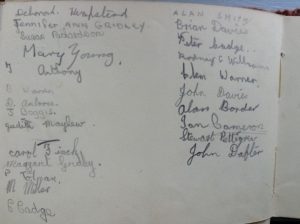
I have autographs of most of the children in my class here, although there are a few missing. (Brian Fraser, Raymond Wicks, Carol Totman, Robert Adams, Robert Ambrose) In the top class I was friends with Mary Young and Tessa Anthony, and Susan Richardson and Roberta Nears as well.
There was a strong sense of being British in the lessons we were taught; History and Geography focussed on Great Britain and the Commonwealth, we learnt about the flags and our patron saints, sang traditional folk songs, and learnt country dancing and maypole dancing round the maypole out the front of the school. There was a large globe on the teacher’s desk, which had huge swathes of countries coloured red (a legacy of the Victorian era of imperialism: ‘the sun never sets on the British Empire’).
We wrote in pencil, in a longhand style which had not really changed since my parents went to school. We had books with special lines in them to practise our letters and later our handwriting, and keep the proportions above and below the line correct. Neat handwriting was considered very important, and practised daily. At least I wasn’t forced to write with my right hand, unlike my Uncle Trevor, who was very left-handed and really suffered because of that, but never managed to write with his right hand. Grandad Cadge was apparently ambidextrous. (As soon as we started at Sudbury Girls’ High School, we were made to write with fountain pens and forced to change our handwriting to a more modern italic style without looped letters (no more capital Qs that looked like 2s), as our teacher, Mrs Wignall, said our writing was old fashioned.)
In summer we would sometimes have lessons outside under the big tree out the front (and girls would take the opportunity to make daisy chains); nearly everybody loved that.
English We concentrated on reading, spelling, comprehension and essay writing. We did study Julius Caesar (and act it out in front of the class – I was Brutus), and we also used to learn poems off by heart. (Hiawatha by Longfellow; Horatius; the Pied Piper of Hamelin; Meg Merrilees.)
I absolutely loved reciting lines from The Song of Hiawatha with their hypnotic rhythm:
By the shores of Gitchee Gumee,
By the shining Big-Sea-Water,
Stood the wigwam of Nokomis,
Daughter of the Moon, Nokomis.
Dark behind it rose the forest,
Rose the black and gloomy pine-trees,
Rose the firs with cones upon them;
Bright before it beat the water,
Beat the clear and sunny water,
Beat the shining Big-Sea-Water.
I remember the ones I learnt with Dad as well – Gilbert and Sullivan soliloquys and Lewis Carroll (You are old, Father William, and The Walrus and the Carpenter). The emphasis at school was on writing correctly, and correct spelling, not particularly on using your imagination, although we did do a competition for the RNLI in top class, and my essay got a commendation for being best in school.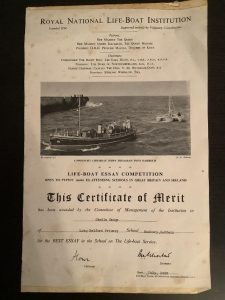
Pauline recalls: ‘Dad had told me as a child that he had eaten a cooked hedgehog, and I believed him and announced this to everyone in my class. At the time we were reading a book about Romany gypsies (The Slowcoach by EV Lucas) and there was a section detailing rolling a hedgehog in clay then baking it in the fire (We read that as well. SC). I can remember expressions of disgust from my fellow classmates. I loved reciting Wordsworth and could envisage the daffodils swaying in the breeze.’ She also recalls productions although she can’t remember what they all were. In one production she was the queen in Alice in Wonderland and Jackie Pilgrim from the railway crossing house at Liston was Alice.
Library by John Davies ‘I was an avid reader and I remember that Mrs Chamberlin, the school secretary, used to look after all the library books that came to the school through the schools’ library service in Bury. Mrs Chamberlin was also the church organist and choir mistress at Holy Trinity Church, where my older sister sang in the choir. Unfairly, looking back, she always gave me first choice of the new books that had arrived- an early lesson in knowing the right people with power and influence!’
Arithmetic This focussed on basic skills, especially mental arithmetic, as there were no calculators available in the ‘50s and ‘60s. We chanted our times tables every day. In the top classes we had to do long multiplication and division, which was especially annoying because we used to do it with ridiculous measures such as weights when you had to use tons, hundredweights, quarters, stones and ounces, and remember how many of each in the next one along (20 112 lbs in cwt, 2 stones in quarter, 14lbs in stone, 16oz in lb), money (guineas, £ s d + farthings) or length (yards feet inches). I still know there are 5280 feet and 1760 yards in a mile without having to think about it. (Could you add together 440 yards and 6 furlongs and give your answer in feet? That is the kind of sum we as 10-year-olds had to do quickly in our heads).
We also had to learn Roman numerals, and do a lot of fractions work, along with some basic geometry and volume work which I found quite difficult, it ended in tears when Dad tried to explain it to me, and I just couldn’t grasp concepts. There was no modern maths, and I never heard of Venn diagrams, sets, and the binary system until the high school. I did however have a couple of exercise books which were covered in esoteric measures on the back, such as rod, pole and perch and troy weight.
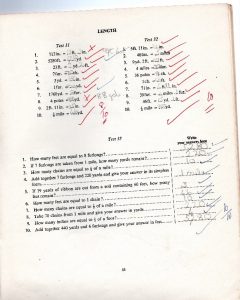
Photo courtesy of Pauline Horne (Cadge)
History was mostly British and some colonial, concentrating on the Romans, kings and queens of England especially the Tudors and Stuarts, the British Empire and Commonwealth, and people such as Clive of India, Livingstone, Florence Nightingale and Elizabeth Fry. Our exercise books were half lined and half plain paper, and we had to copy pictures of people such as Sir Francis Drake and then write about them. John remembers us doing a painting for an exhibition at Gainsborough’ s House in Mrs Gooch’s class, that we then went to see. He says ‘I remember doing one of Charles ll and was really envious of people who could draw. I was useless and my picture was relegated to an obscure corner of the display.’ I can’t remember that, but any picture I did would also have been relegated, I was hopeless at art.
Geography was mainly knowing where countries were, their capitals, what they produced and whether they were part of the Commonwealth. We learnt about our local region as well. Pauline says: ‘I remember learning about all the docks. When you go to London now and see all the trendy eating establishments on the docks where the dockers would once have laboured it doesn’t seem possible. I think it was probably in the penultimate year before I left, the school purchased two large relief maps. They were placed on a table and water was poured over them so we could see the water running from the higher ground into the sea/ocean. Thereafter they were hung from the wall and the watering can wasn’t brought out again.’
PE and Games We would do PE in the school hall, and in the top classes the boys used to go down to the football field one afternoon a week while the girls played netball in the boys’ playground. There were no markings, so a couple of girls were sent out with a long skipping rope and a piece of chalk to mark out the court over dinnertime each time we needed to use it. I used to enjoy when it was my turn to do this. We had to get the netball posts from an outhouse and erect them as well. (I can’t remember any adult supervision when we were doing this). We did have a school netball team coached by Mrs Gooch, which played other schools, but I was never on it as I wasn’t that good. Cousins Jenny and Margaret Gridley, and Jean Boggis, were really good at netball. I much preferred hockey when I started at the High School. We wore coloured bands to distinguish which team we were on. I remember at one point my PE shorts were navy, they had been made from a pair of Dad’s old work overalls, and Mum sewed pink rickrack along the pockets to brighten them up a bit. Every year we had a Sports Day when we would all troop down the football field for all the usual running and jumping events, along with fun races such as three-legged, egg and spoon, bean bag, sack and relay races. In my final year the competition was between the four houses to see which one could get most points.
Pauline also remembers cross country running down School Lane and across the fields for quite some distance. It could be a cold and muddy exercise.
Boys’ Games lessons by John Davies ‘Many of us were sport mad and one of the sad things looking back at our primary school era was how poor the opportunities and facilities for sport were at the school and indeed in the village generally, especially for the young.
We were taken regularly, weather and ground conditions permitting, by Mr Danks, Mr Fox or Mr Partridge to the hallowed turf of Stoneylands – the home of Melford FC- where many of us spent our Saturday afternoons following the fortunes of Melford and Melford Reserves in their famous black and white stripes. From school we would walk to the ground and return to school covered in mud and sweat for the rest of the day. There was no coaching and we often had to play across the pitch as the groundsmen Sid and Bernard Mills were not keen on us using the goalmouths where, into the season, grass was often in short supply.
Despite these shortcomings we still managed to field good sides as many of us spent hours playing football outside of school. We played occasional games against neighbouring schools. I remember playing in a primary school semi-final at RAF Honington near Bury when we took a coach full of supporters from the rest of the school. Soon after arrival these supporters were ‘attacked’ by supporters from another school with what we called ‘buzz bombs’- stalks of wheat with a clod of mud attached at the bottom. Teachers had to move the rival supporters to opposite sides of the pitch and we lost as well! We put our defeat down to travel sickness as many of the team felt quite queasy after a bus journey around winding Suffolk lanes in a Theobalds’ coach!
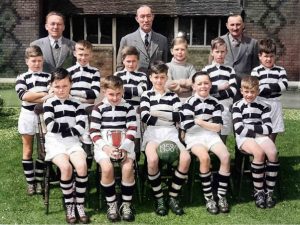
Football Team 1958 -59 L to R Staff: RD Danks, RW Partridge, WF Fox Top: Colin Ellwood, Ben Howard, Charles Lawson, Michael Boggis, Raymond Hebditch, David Totman. Bottom Paul Adams, Michael Younger, John Bugg, Nigel Boggis, Peter Howe. Photo courtesy of LMHC (originally In Suffolk Free Press)
In summer we played cricket and had our school sports day at the football ground and also on one occasion on the field next to the school where the community centre car park now stands. I fancied myself as a 100-yard sprinter and did well enough to represent the school at an inter-school athletics gala at Clare Secondary Modern School. Sadly, the boy in the lane next to me was wearing proper running spikes and disappeared into the distance at a rate of knots. My battered old plimsolls were no match!’
In the run-up to Christmas, we did country dancing in the hall, learning dances such as Dashing White Sergeants and Haste to the Wedding. Keith recalls most boys detested country dancing and some would often turn up in their gardening wellies to try to avoid it, while John also remembers this activity. He said his two dance partners ‘were Brenda Warren and Margaret Gridley, who probably still have bruised feet as a reminder! We were never allowed to choose our dancing partners. Instead, we were all lined up in descending height order into two rows, boys opposite the girls, and your partner was the one opposite you and around your height!
We also did maypole dancing at one stage and performed around the pole on the front lawn of the school and at the church fete at either Montgomery House or Westgate House.’
Science Astonishingly Science is not even mentioned as a subject on the school report. What we learnt was pretty rudimentary, we did some nature study and nature walks and a bit about how the human body functioned, and topics such as the solar system and electricity and gravity, but that is about all I can bring to mind. (I remember Dad showing me how the phases of the moon and eclipses happened at home. He drew the curtains, gave me a torch, and then held different sizes of rubber balls, moving them about so that the ‘sun’ at the back was obscured by the smaller ‘moon’ which was nearer to the torch I was aiming at the balls.) As already mentioned, we had a nature table in the corner of the classroom and the Shell posters on the wall. Maureen used to love the nature walks. She has recollections of going down School Lane and being taught about the different trees, she loved the lessons about different kinds of clouds such as cirrus and cumulus. She was talking to her older brother Roger, (everyone called him Wilf), and he said that on the nature walks, the boys’ favourite trick was to pick the rose hips, open them up and shove them down a girl’s back because the seeds were itchy. He seems to remember that the boys and girls were kept in separate walking lines so they must have sneaked up behind them.
I do have memories of Mr Partridge once trying to explain about sweating to a bamboozled class but he made it so complicated none of us worked out what he was talking about. John recalled ‘taking in an enormous caterpillar from an elephant hawk moth that my dad had found on a fruit tree. It filled the full length of a 1lb size jam jar and remains the largest caterpillar I have seen. Kelvin Cracknell and I used to take it out of the jar and let it crawl along our desks to make the girls scream when we were in Mrs Gooch’s class for the first time.’
A fishy story by John Davies ‘Several of us were keen on fishing whilst at Melford School and every fishing season we would get our licences from Ivan Turner, the father of Keith and Philip Turner, in St Catherine’s Road. One of our very favourite fishing locations was all along the Chad Brook from near the Village Hall to the railway bridge in Broad Meadow. We even gave our favoured spots names such as ‘the S bend’ behind the football field – best for roach- or ‘Dace Corner’ at Smaley Lane. We used to catch a lot of fish. Before the little weir was built, we used to go fishing with our jam jars rather than rods under the then wooden bridge that crossed over the Chad Brook to the allotments. We would put our wellies on and carefully turn over the large stones on the river bed to catch gudgeons and miller’s thumbs in huge numbers.
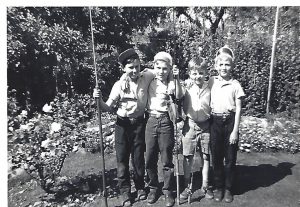 L to R: Peter Brent, John Davies, Melvyn Roscoe, Brian Davies Around 1960. Note the snake belts holding up their trousers- all the rage for boys then!
L to R: Peter Brent, John Davies, Melvyn Roscoe, Brian Davies Around 1960. Note the snake belts holding up their trousers- all the rage for boys then!
The fishing rod John is holding was made by his dad from a WW2 tank aerial!
Photo courtesy of John Davies/Peter Brent
Inevitably one day we thought it would be a great idea to take some of our captures into school for the nature table and to stock the little pond in the school allotment gardens. We took the fish home and put them in a large metal wash tub used by our grandma and mother to do the washing every Monday in those pre-washing machine days! We were told in no uncertain terms that the fish would not survive without flowing water and oxygen but of course we would have none of it. Next morning all the fish were dead and we never got to take any into school though we did keep all our classrooms supplied with frog spawn in the season to watch the tadpoles hatch out to be released into the school pond.’
Art and Craft In no particular order these are all the various types of work and media I remember over the years: sometimes we would go and sit outside to draw things, we used pencils, charcoal, pastels, coloured pencils, Crayola crayons and powder paints which came from big tins, and plasticine. The Gloy glue we used came in little glass bottles with red rubber tops with slits in them which always seemed to have stuck together when you came to use it. You had to stab the rubber top with a sharp scissor point to get the glue out. I used to like sharpening my pencils in the big pencil sharpener attached to the teacher’s desk.
Being left-handed I struggled with all the directions being the wrong way round, and I never have learned to knit or crochet properly. I did quite enjoy the mushroom/cotton reel tube knitting round four pins (aka French knitting) though.
I preferred sewing. It seemed we practised embroidery stitches on endless tray cloths and dressing table sets, which got taken home as presents for our long-suffering mothers and grannies. When I look back at my Nana’s work, (or other girls of a similar age, who were making beautiful samplers with counted stitches,) where she was crocheting delicate borders round tray cloths, our work was really basic compared with those little girls of two generations earlier. In top class we had to make a plimsoll bag for ourselves, and each girl had to make one for a boy in the class as well, and embroider names on them in stem stitch. I was allotted John Davies. I wonder if anyone else remembers having to do that. While we were sewing, the boys were gardening…
Gardening by John Davies ‘In those unenlightened times gardening was the sole preserve of boys, and also only those in the top two classes. Time was given in the curriculum on the basis that it was good outdoor exercise and we were a rural school where learning horticultural skills would hold you in good stead. The school was also blessed with good-sized grounds with lawns, shrubbery and trees and, importantly, a sizeable rear garden that could be divided up into allotment plots.
Unbelievably, in those pre-health and safety obsessed days, we were let loose with the full range of garden tools and equipment – spades, forks, hoes, lawn mowers, shears, secateurs and saws; and very enjoyable it was too! We would take it in turns to mow the front lawns with a hand-drawn mower, and to tidy the shrubbery and yew trees with saws and secateurs, including the tall trees that ran along the border with School Lane, which we were allowed to climb to trim branches!
In the rear garden, each of the allotment plots, probably about a dozen in number, was given to two to three boys per plot to clear, dig over, manure, plant, weed and maintain. The school PTA provided the seeds and potatoes from its funds, and the tools had been donated over the years. Water came from a tap on site and there was a small rectangular brick-built pond as well.
Two incidents from these gardening lessons have remained in my memory. The first was when one of our classmates, John Dafter, managed to put a fork through his foot and fell over when he tried to lift the fork off the ground much to our amusement despite his injury. The second was when we had dug over all our plots and were told by the teacher that they now needed flattening and raking prior to sowing. ‘Busty’ Mills, a well-built boy, simply threw himself on the ground and rolled over everyone’s plots to flatten them out still wearing his school clothes!
Prizes were given for the best maintained plots. As most of the produce we grew matured during our long summer holidays we never did get to sample the products of our labours!’
(Keith couldn’t remember too much about gardening although he did remember, when he was much younger, possibly before he started school, setting a line of chicken feathers at home (the family kept chickens) and when his parents asked him what he was doing he said he was going to grow some chickens.)
Music usually took place in the school hall. There was a schools’ radio programme called Music and Movement which involved activities like listening to music and pretending to be trees growing and swaying in the wind, waving our arms in the air. The school had large posters of sheet music which could be fastened to a blackboard so the whole class could follow it at the same time, and there were different coloured lines of notation for different percussion instruments such as triangles, tambourines, cymbals and castanets. Most of the class ended up with triangles, which I thought were really boring, I much preferred tambourines or cymbals. In the top classes there was the option of joining a recorder group, but I never got much beyond Three Blind Mice on the descant recorder. Pauline progressed a bit further than me, she says: ‘I can remember playing an excerpt from the Blue Danube at school, and we performed in the evening in front of parents. I had trouble with the high notes where it goes do do and my recorder made a very squeaky noise. I think I wasn’t half covering the hole on the back of the recorder properly.’ She also remembers some musicians, probably peripatetic music teachers, turning up to play in order to encourage the children to start learning instruments such as the violin.
Mrs Chamberlin played the piano while we attempted songs such as Cherry Ripe, Who is Sylvia? and Nymphs and Shepherds Come Away. My favourite bit was warbling ‘Peel’s view halloooo would awaken the dead’ in ‘D’ye ken John Peel?’ I did audition for the school choir, but Mrs Bixby said I couldn’t be in it because I was a growler. (I never got over it. She said the same about Susan Richardson.) ..So I never got to take part in the nativity play choir at Melford Hall. However, Susan was picked by Mr Partridge to be in the choir.
Scripture was nearly all Bible knowledge and Bible stories, and we also learnt about patron saints, and St Edmund and his struggles against the Danes. As we attended a church school, children had the opportunity to take the Bishop’s Examination in Religious Knowledge, and Susan Richardson, whose certificate we see here, passed with Credit.
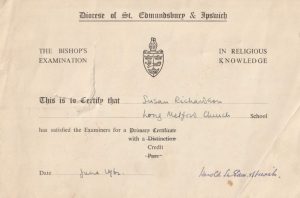
Photo courtesy of Sue Smith (Richardson)
Other events in the school year
Health We would be visited regularly by the school nurse. There was no medical room in the school, so she would take over Mr Partridge’s office, which always felt cold, for routine health checks. She would measure height and weight and check for nits. We received our polio vaccine, which was drops on sugar lumps, in the school hall. There were also yearly eye and hearing tests, and Annabel remembered the school dentist, who she described as horrible. Nobody looked forward to those visits!
Having your tonsils out, although it has now fallen from favour, was a popular operation then, and a common reason for absence. I never had mine removed, but I seem to remember the aftercare involved eating ice cream and crisps. Although we were vaccinated against polio, there were no vaccines for measles, German measles, mumps or chicken pox, so outbreaks were frequent with several children off at the same time. If you were off school ill for any reason, you might spend the day curled up on the couch under an eiderdown and the (relatively expensive) Lucozade would appear, we never got the opportunity to drink it any other time.
Depending on the severity, if a child felt ill in school, they would either be told to sit quietly in the classroom, maybe go and sit outside Mr Partridge’s office, or get sent or taken home. Pauline remembers our sister Pam having a stomach upset and Mr Partridge kindly took them home in his car. (she thinks it was an Austin 1100, quite a new car). They sat on the back seat which had been covered in brown paper, she imagines in case there were any more upsets. She was quite pleased to be going home as she was fine, but no doubt he was expecting her to go down with it too.
She also recalls a girl fainting at school and she was put outside the front of the school lying on an old camp bed (probably ex-army issue like so many things were) to recover, near where the staff cars were parked. This was in front of the school house (where the remedial learners were at that time taught by Mrs Partridge). Nobody would have seen if she was abducted as the windows were too high to look out of.
Christmas As in countless other primary schools throughout the land, excitement would mount as Christmas approached. We made crepe paper garlands to hang across the classroom, and put together decorations from different coloured paper strips which came in wads glued at both ends, and you just had to lick them to complete the circle and link together in long chains.
We also made and sent Christmas cards, practised carols and the nativity play, and in the last week of term enjoyed Christmas quizzes and games in the classroom. The hall and other areas were decorated festively, hung with paper chains and garlands, and there was a big Christmas tree festooned with decorations and balloons in the back corner of the hall.
In the last week of term there would be parties for all the children in the school. We had a sit-down tea along trestle tables in the school hall with sandwiches and jelly and ice cream and cake, and crackers and balloons, and we played all kinds of party games. One year I remember there was a competition for the best Christmas hat, and Ian Cameron won, hands down. He was wearing a huge rocket made from a cardboard box and covered with crepe paper, I don’t know how he managed to walk around without it slipping off!

Christmas party 1957 Photo courtesy of LMHC
In 1961 there was a very special Nativity play at Melford Hall across the road from the school. The top classes of the school performed this over a couple of nights, utilising the main entrance hall and the massive staircase. Clem Warner was Joseph, Diane Ambrose (?) was Mary, Ian Cameron and Peter Hebditch were shepherds. John was one of the men at the inn, he says it was an atmospheric occasion and he couldn’t get over how spacious Melford Hall was compared to their little terrace house in St Catherine’s Rd.
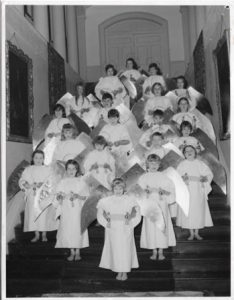
This picture shows the choir of angels on the staircase there. The children who sang solo were Susan Beevis, Deborah Hempstead, Mary Young and Jane Todd.
from the top Jackie Waite, Susan Beevis, Susan Robbins, Diane Allen, Raymond Hurrell, Roberta Nears, Susan Richardson, Deborah Hempstead, Malcolm Gridley, Ann Tolchard, Mary Young, Tessa Anthony, Paul Squirrell, Elizabeth Waite, Janet Harrison, Linda Haydon, Jane Todd and Jacky Boggis. Photo and information courtesy of Sue Smith
It was a huge occasion for the school and part of the event was televised on the regional news, which made it understandably overwhelming for some of the children involved.
Maureen Lilley was supposed to have been an angel but she pulled out last minute partly because she was too shy. Although Susan Richardson was in some photos, she wasn’t there on the night. She was really unwell with the flu and scared her mum because she kept saying ‘but I want to be an angel’. Jane Todd also remembers Debbie Hempstead being poorly and having to go upstairs to the bedroom at one point.
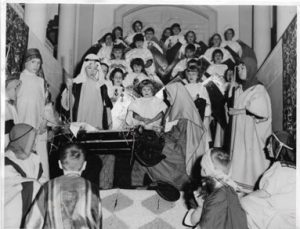
Photo courtesy of Sue Smith
The changing room for the production was in the old servants’ kitchens under the staircase. Brian Davies managed to fall over in the corridor leading to the staircase and break the hurricane lamp that he was carrying. He can remember being shouted at by Freda Ford, one of the ladies in the PTA who was helping out.
Cycling proficiency test: There was outside tuition for this test, and we had to bring our own bikes to school to take part (mine was a shiny red one and I loved it.) As well as teaching us how to ride safely and the rules of the road, the policeman who took the test checked that the bikes were roadworthy and showed you how to fix basic problems such as fixing punctures or the chain coming off. If you passed you got a metal badge and a certificate.
I remember doing the training for this but I don’t think I ever took the test. As you can see from this picture, there were no cycle helmets for children available at that time.
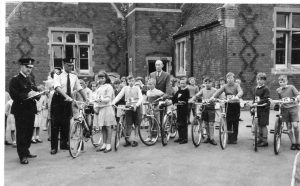
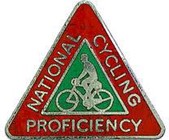
Cycling proficiency tests: L to R: Susan Robbins, Raymond Elms, Peter Bugg, Melvin Boggis, Malcolm Gridley, Alan Border, Kelvin Cracknell, John Davies. Mr Partridge in the background. Photo courtesy of Karen Cole
Prize giving Every year in summer there would be a prize giving afternoon where parents were invited to see their children get books (quite often children’s literature or about nature) handed out as progress prizes, and other certificates.
Two prizes were awarded for progress in each class, one for girls and one for boys, and different children were awarded prizes each year. I received the girls’ prize in Class 6, and Ian Cameron received the prize for the boys, his book was the companion volume to mine,
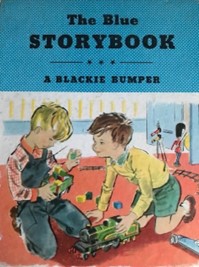

The Red Storybook. Keith received The Water Babies by Charles Kingsley as a prize one year.
John Davies writes: ‘I was fortunate enough to receive class prizes on a number of occasions at Melford School. One prize when I was in Mrs Gooch’s class when I was about eight was a history book covering the history of Britain through kings and queens and major events with evocative colour illustrations and stories. It fired my imagination and I must have read it a hundred times. It started for me a love of history that I subsequently went on to study at university. From small beginnings!’
The picture below of prize winners the year after I left was taken in the boys’ playground. You can see the bike shed and the sheds used for coke and to store equipment in the background.

Prizegiving awards in 1964.
Photo courtesy of Kevin Davey
L to R from back row: ?, John Loveless, Christopher Tolchard, Peter Hebditch, Paul Moase, Peter Richardson, Keith Turner, Glen Hurrell, Paul Johnson
Mandy Blackwell, Margaret Balaam, Jacky Boggis, Linda Haydon, Elizabeth Waite, Marilyn Cadge, Judy Cadge, Susan Hudson, ? (in front of Susan), Carmel Henderson, Michael Theobald, Martin Hempstead, Mr Partridge, ? (partly visible with shield)
(Just visible) Gail Henderson, Jenny Holder, ?, ?, Linda Totman, Stuart Barclay, ? , Richard Oakman, Stephen Ward
Wendy Dodd, ? , Marion Beere, Nicola Lewis, Lorraine Henderson, ?, ?, ?, Nigel Steward
Janet Smith, Joanne Johnson, Joyce Burman, Andrew Moase, Malcolm Gridley, ?, Jackie Pilgrim, David Williams
Chris Golynia, Andrew Fraser, Julia Wicks, Patricia Ambrose, ?, Kevin Davey, Ann Theobald, John Adams
There are seven of my cousins on here: Marilyn Cadge, Judy Cadge, Michael Theobald, Nigel Steward, Stephen Ward, Malcolm Gridley, and Kevin Davey sitting on the right in the very front row.
School reports As with every other school in the country we received school reports at the end of the year, which told our parents how good our attendance and conduct had been, along with how we were progressing in the various subjects. (As I mentioned before, Science is not even included as a subject). Several subjects received one-word comments.
Looking at some of the reports that I have seen, I think it would have been difficult at times for parents to work out the difference in achievement between some cryptic comments such as: ‘Fairly Good’, ‘Very Fair’, ‘Fair’, and ‘Only Fair’.
Maureen Lilley enjoyed school and got good reports, with the comment in Mrs Bixby’s class that her conduct was (like many other children) good but ‘inclined to be rather talkative’
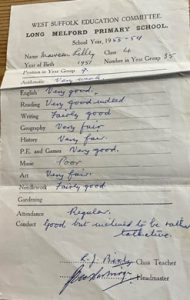
Photo courtesy of Maureen Clayton
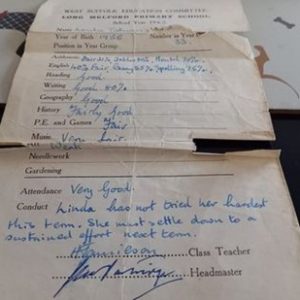 Linda Totman was ‘a very cheerful pupil’ according to Mrs Morris. In top class Mr Partridge thought Linda had great musical talent and might consider music as a career.
Linda Totman was ‘a very cheerful pupil’ according to Mrs Morris. In top class Mr Partridge thought Linda had great musical talent and might consider music as a career.
The report here shows that while she was doing well in lessons, Mr Jamieson was not quite so pleased with her conduct when she was in his class. ‘Linda has not tried her hardest this term She must settle down to a sustained effort next term.’ (In her defence, Linda reckons it was because he was gorgeous, she didn’t want to work, she was happy just to swoon. (she was not the only one, Mr Jamieson was always surrounded by girls when he was on playground duty or between lessons))
Photo courtesy of Linda Aldous (Totman)
Mrs Gooch’s report for Susan Richardson in Class 1 was by contrast very informative, and gave a much better idea of progress, compared to Maureen’s for Class 4. This would be the final report before we all went to the High School in September that year.
Photo courtesy of Sue Smith
School photos Every year a photographer came to take everyone’s picture. We would then receive proofs a couple of weeks later to take home, and our parents could choose whether to keep them or return them and order more. They were quite expensive, but a lot of parents decided to buy them as Christmas presents for relatives, especially as it was nowhere near as common for ordinary families to have photoshoots, or even take photos then.
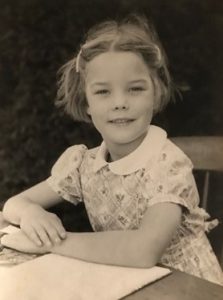
My school photo in 1959
We posed for the photo sitting outside at a table with our arms folded over a book. I don’t think that the photographer took class photos, or if they did, I’ve never seen one – a real shame, as it would be such a wonderful keepsake!
School outings At various times over the years, children went on excursions to Arundel, Dovercourt, London and other places, I can only remember going to London Zoo in any detail, and visiting Gainsborough’s House to see an exhibition, although I am sure there would have been other outings as well, such as to Bury St Edmunds. I loved seeing all the animals that Desmond Morris talked about in Zoo Time on the television. We saw elephants giving people rides, watched the chimpanzees’ tea party and visited the Penguin Pool and Reptile House as well as many other areas of the zoo. As part of the trip, several of us bought postcards and twopenny halfpenny stamps (postcard rate) so we could post them there and get a zoo postmark. I chose a rhino to send to my parents. My sisters went to Heathrow Airport, they would much rather have gone to the zoo.
Centenary celebrations The end of April 1960 saw over a week of activities to celebrate the hundred years since the laying of the foundation stone of our school in 1860.
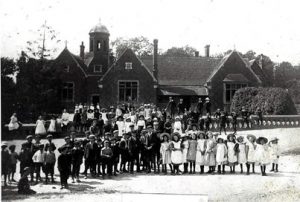
Children outside Long Melford Old School circa 1905. Photo courtesy of LMHC
All children received a copy of a commemorative leaflet printed on pale green paper to take home as well as a piece of cake. The centenary cake was baked by my aunt Maudie Gridley, and she came into school assembly to pose for press photos, accompanied by school children, and also by members of the PTA.
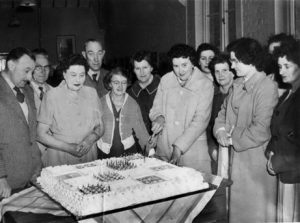
L to R: Members of the PTA celebrating the centenary. Mr Fox, Mr Danks, Mrs Smith, Mr Partridge, Mrs Evans, Mrs Barclay, my aunt Maudie Gridley, Freda Ford, Elsie Woodhouse, Betty Warren, Monica Hempstead (just visible), Mrs Beales. Photo courtesy of the Sandham Collection
She then made the first cut and all children were given a piece to take home. Fiona Johnson was at the school for the centenary celebrations, and recalls the big cake being brought into assembly, (She lived at Rodbridge where the Country Park is now, and remembers Landis Wheeler, Jane Wall, Colin Cadge, Michael Boggis, Linda Green, and Jean Ranson. She moved away in 1961.) Following football and netball matches on the Tuesday, the programme of centenary celebrations included a church service presided over by Reverend Simpson on the Wednesday, where the school choir sang a couple of hymns: For the might of Thine arm we bless Thee, and My faith it is an oaken staff. There was a dance in the village hall on the Friday, and on Wednesday 4th May there was an open afternoon at school for former pupils over 60 years of age. Maypole dancing was involved at some point as well.

Maudie Gridley with Mr Partridge the headmaster (I’m about four rows back on the extreme left, you can just see my right eye and forehead)
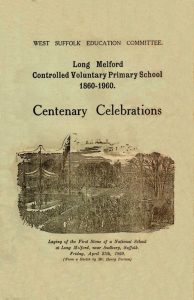
The leaflet included lists of the names of school managers, school staff, and a list of former headmasters (no complete list of former headmistresses was available): Mr W Snell 1860-73; Mr J Phillips 1874-1900; Mr JH Whitehead 1900-05; Mr JW Pullam 1906-12; Mr CH Moore 1913-25; Mr GO Chamberlin 1925-54. It also contained the names of members of the Parent Teacher Association.
Photo courtesy of LMHC
The laying of the foundation stone The leaflet contained an engraving and account of ‘the new school now in the course of erection for this extensive village’ which appeared in the Illustrated London News April 29th 1860. Following the Divine Service in Holy Trinity Church led by Rev. WS Baker, where this large and ancient edifice was crowded with a most extensive congregation, a procession formed at the old school or Ladye (sic) Chapel. The procession consisted of Sudbury Brass Band; the clergy present two by two; the architect AH Parkin Esq. from London; churchwardens and members of the local building committee; wardens and brethren of Melford Hospital; workmen headed by Mr Fordham the contractor; Lady Parker and Mrs WS Baker; 350 children, with each class bearing a banner. The procession wound its way past over 2000 spectators on the Green down to the site for the new school. A canopy had been erected decorated with flags and evergreens, and after prayers Lady Parker laid the stone. The national anthem was then sung, followed by three cheers for Lady Parker. Through the kindness of Reverend Baker and his wife, all the children were regaled with cake and wine. Various other parties sat down to lunch at local big houses.
The school was to be built in the Elizabethan style, and designed to have accommodation for 250 boys and girls, with two separate schools under the same roof. There were also two residences for a master and a mistress. Charles Fordham, builder of Melford, was awarded the contract at around £1600.
11+ The school’s be-all and end-all in the top two years was to try and get as many people as possible through the 11+; it seemed to me you were always doing tests or practising for the three parts of the test – English, Arithmetic and Reasoning. The tests took place in February and the girls did theirs at Sudbury High School for Girls in 1963. When numbers increased in later years children would sit the exam in Melford School hall.
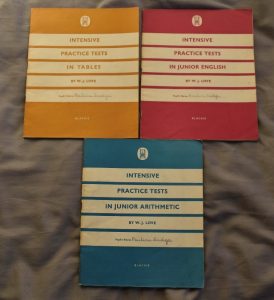
Practice test books for the 11+
Photo courtesy of Pauline Horne
Sitting the 11+ exam by John Davies
‘Looking back, the 11+ was a hugely significant event in our young lives and probably shaped to some extent what we did with the rest of our lives. Thankfully at the time I don’t remember being overly concerned and have no recollection of pressure being applied on us. We were well prepared in a good way by Mrs Gooch. It probably helped that our 11+ took place in February in one of the coldest winters on record in 1962-63 when the school was shut on a number of occasions because of frozen pipes and no toilets. I think there was a lot of snow on the ground when we sat the exam.
The boys sat their exam separately from the girls (a sign of things to come!) at Sudbury Secondary Modern School. Mr Partridge, the headteacher, had delivered letters to our homes telling us the time and pick up locations we were to use to catch the bus taking us to the exam. I can’t remember much detail of the exam but I think there were sections on arithmetic, comprehension, general intelligence/ knowledge and a written essay. My twin brother remembers having to write an essay about red snakes!’
That year six or seven girls and six boys passed from our school, which was a really high percentage for a small village school. (If you passed the exam, you were given the option of going to Sudbury, Bury St Edmunds Grammar School, or Newmarket Grammar School. Ardyn Smith is the only person I can remember whose parents opted for Bury rather than Sudbury.) The boys found out just before the end of the summer term if they had passed or not, as there were two boys’ schools: Sudbury Grammar School, which was an ancient institution, and Sudbury Secondary Modern School.
Everyone was given an envelope to take home, which included details of uniform; this was obviously different depending on which school they were going to attend, but as the girls all went to the High School, they had to wait until September when they were put in classes to find out if they had passed, which always seemed unfair to me. I was a rare exception, as I was allowed to take the exam a year early, and so I had to find out, otherwise I would have stayed in Melford for another year. Pauline remembered a couple of the boys in her class were on the borderline as to whether they should go to the grammar school or secondary modern. They came to school very smartly dressed on the day of the interview in Sudbury.
Changing times by Pauline Cadge
‘I was four and a half when I started school at St Catherine’s Road in September 1961. I went up to the top school the following September. I can’t remember if I spent two years in the top class or class 2. In those few years progress had started to occur with more modern teaching ideas.
For example, a few of us in the top class, who the school felt needed extending, were put on the Nuffield Maths series of books, which explored more abstract ideas such as equations and more lateral thinking. We came across the binary system in these books. There were also the usual questions, such as which is heavier, one ton of feathers or one ton of coal? I obviously got weight and volume muddled up as I can remember answering feathers! Peter Merritt (now sadly no longer with us) was an absolute whizz at the questions and knew more or less straightaway what a and b represented but I struggled to get the answers quickly like he did.
Mrs Gooch started to teach us italic handwriting in the top class in preparation for us going into secondary education. I’m sure we used fountain pens. She had a big bottle of Stephen’s ink that we filled our pens up with. John mentioned about having to go to Mr Partridge’s office to read to see if he could change to a book at the next level. I can remember doing the same. It was a story about a hind and her fawn. The hind was telling the fawn to get up. However, I couldn’t give a proper explanation of the adverb in the story so didn’t go up to the next reading scheme. I was so disappointed. We had the same reading books (i.e. Chicken Licken) but by that time Janet and John had also made an appearance.
I can remember the arrival of a large black and white TV with lockable doors in a pale wooden cabinet. Once a week we watched a schools’ programme but I can’t remember what it was called.
I remember that some of the children had art or craft work displayed at Gainsborough’s House, which held its first exhibition of contemporary artists in September 1959, and opened as a museum in 1961. I had a yellow knitted dolls dress that I made. I sweated blood and tears making that, unpicking mistakes several times! ‘
It would only be a decade or so before the 11+ was abolished in Suffolk, and from 1972 onwards all Melford children would go to middle school at the age of nine (the former Sudbury Girls’ High School site was converted into Uplands Middle School), and then move again at the age of 13 to Sudbury Upper School, a newly-built co-educational comprehensive.
Post script
I actually went back to my old primary school for a week’s teaching observation in July 1974, when everyone was getting ready to move to the new premises in Cordell Road, and the building was entering its final months as a school. Nearly all the staff had changed by then, and there were no teachers remaining who had taught me.
On one of the days, I joined a coach trip to Ipswich as an extra pair of hands to help supervise. Several of the children had managed to eat their lunch before we even left Melford, and at least one child was sick more or less straight away (some things never change!). The main thing I remember from that week, however, is how small the building and all the classrooms seemed, especially the hall, which had felt huge when I was there as a child. I’m so glad I got that opportunity to say goodbye before the school closed its doors to pupils for ever.
I have a great affection for my time at Long Melford Primary School, and I would like to dedicate this article to all staff and children who ever attended or worked at that lovely little school. I hope these reminiscences bring back good memories.
Sheila Cadge 2024
Acknowledgements
My special thanks to classmate John Davies who filled in all the gaps about what the boys got up to when they weren’t with the girls, along with other anecdotes. In Appendix A he has also shared his recollections of the Roman finds when the sewerage system was being laid. Thanks to John, my sister Pauline, Maureen Clayton and Keith Slater for reading drafts and offering suggestions and valuable extra material.
Thank you to Long Melford Heritage Centre (LMHC) and Long Melford Historical and Archaeological Society (LMHAS) for allowing me to use some of the photos in their archive, and to all the group members who helped provide missing names for some of the photographs. Some photos appeared originally in the Suffolk Free Press.
Thank you also to the following people who have contributed photographs and/or memories:
Linda Aldous (Totman)
Peter Brent
Debbie Capon (Hempstead)
Maureen Clayton (Lilley)
Karen Cole
Kevin Davey
Brian Davies
Annabel Guimont (Blackwell)
Jane Hazelden (Todd)
Pauline Horne (Cadge)
Stephen Horne
Patricia Leathers (Brewster)
Fiona Maxwell (Johnson)
John Nunn
Rita Rowley (Hempstead)
Ian Sandham and the Sandham archive
Colin Saunders
Sue Smith (Richardson)
David Underwood
Brian Webber
Other sources
Wikipedia
Suffolk Free Press
Long Melford Heritage Centre (LMHC)
Long Melford Historical and Archaeological Society (LMHAS)
The ‘hive memory’ of former primary school pupils
Apologies for any errors or omissions.
Appendix A
Some schoolboy memories of Roman finds in Melford 1958-60 by John Davies
In 1958 many pupils at Melford School were looking forward to the arrival at last in many parts of the village of a new sewerage system and to waving goodbye to the antiquated outdoor privies and the weekly emptying of the night soil that had been part of their lives to date!
Our interest in the excavation work for the new sewerage system and the trenches that were starting to appear all over the village was heightened with the amazing discovery of a Roman villa at the bottom of St Catherine’s Road and Liston Lane in what we all called Cutler’s Park- the grazing pastures to the rear of Melford Place Farm. Even more exciting for us St Catherine’s Road residents in the months that followed was that the sewerage and gas pipe trenches dug in the back gardens of the houses that backed onto Liston Lane started to reveal over the next two years many further Roman remains!
The mechanical excavator used to begin the initial digging of a sewerage trench across Cutler’s Park cut through a white limestone tessellated pavement surrounded by red tiles. Norman Smedley’s 1961 account, Roman Long Melford, records that ‘it was due to the prompt action of Mr Wickham Partridge (our school headmaster) that observation was enabled to be kept on operations at this very early stage, and that the remainder of an obviously important site was saved from destruction.’ Unbeknown to us at the time Mr Partridge was a keen amateur archaeologist and as the article also notes ‘he continued throughout to act as a most useful and competent local observer and correspondent. (…)the children attending his school were assiduous collectors.’
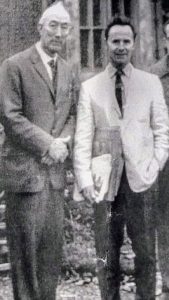
Robert Wickham Partridge (left), Melford School headmaster, and Neville ‘Bob’ Byford (right), village postmaster. They both became founder members of the Long Melford Historical and Archaeological Society in 1969 (LMHAS Newsletter Sept 2009) Photo courtesy of LMHAS
Mr Partridge was joined in his endeavours by Melford’s then postmaster Neville ‘Bob’ Byford, another keen amateur archaeologist, whose garden behind the then post office (now the Pharmacy next door to the present post office) yielded many interesting finds of Roman pottery. Nearby Cock and Bell Lane delivered up pottery, storage jars, skull fragments and a male skeleton whilst across the road in Woollards Gardens the skeleton of a young girl was found with bronze bracelets and a jet ring. Mr Byford’s efforts in securing these finds was rightly acknowledged at the time as he ‘brought knowledge and enthusiasm to the task of dealing with many sites (…) not only collected much interesting material but was instrumental in directing other finds to the Ipswich Museum either as gifts or on loan for study.’
The leadership role of these two Melfordians is a reminder that in the 1950s archaeology was often still the preserve of knowledgeable, enthusiastic amateurs supported by a sprinkling of professionals from county museums who were hugely reliant on the help of local volunteers. (well-illustrated in the film The Dig with the role of amateur Suffolk archaeologist, Basil Brown, at the Sutton Hoo discoveries.)
In a similar fashion the securing and care of the discovered sites was carried out in a very ad hoc fashion compared to today – generally people were not so bothered about preserving our heritage. (My classmate Sheila Cadge, now involved at Hadrian’s Wall in Northumberland, has found that bits of Hadrian’s Wall were still being blasted away at Walltown, which was then a working quarry, until 1976. It was the view of some of the quarry workers there that if they found anything Roman, they would destroy it so they didn’t have to stop work – no work, no pay!)
The Cutler’s Park Roman site was, looking back, in a very vulnerable and accessible location as far as the adults and children of the village were concerned! There was no site security and I can remember that the trenches were simply covered when the workmen left with corrugated tin sheets. These were easily pulled back by the adults and children who visited the site in the evening or at weekends to have a closer look at what was being uncovered by the digging. My twin brother Brian can remember picking up pieces of pottery from the earth mounds created by the workmen around the trenches. Peter Brent (ex-St Catherine’s Road) also remembers that Mr Partridge told us that The Dip in Cutler’s meadow (where we used to hide when Mr Cutler and others came by!) was probably the remains of a Roman trench dug to protect the settlement.
Cutler’s Park was also where the farm’s Friesian dairy herd were put out to graze between their twice daily milking in the dairy at Melford Place Farm and where the cows waited to be led past the Roman site next to the five-bar gate and on to Liston Lane. The cowman would then walk them up and over Liston railway crossing and into the grazing on Broad Meadow. The newly discovered Roman site was often surrounded by a large herd of Friesian cows. Further into the park in the middle of the farm track that led up to the milking parlour a further trench had been dug, and in this trench a Roman iron knife and a bronze hand mirror were discovered. Opposite the Roman villa on the site of the present bungalow where St Catherine’s Road joins Liston Lane, a further workmen’s trench uncovered handmade pottery, tiles and animal bones as well as, thrillingly for us children, a female skeleton that subsequent study revealed suffered from severe osteoarthritis and had suffered repeated blows to the head.
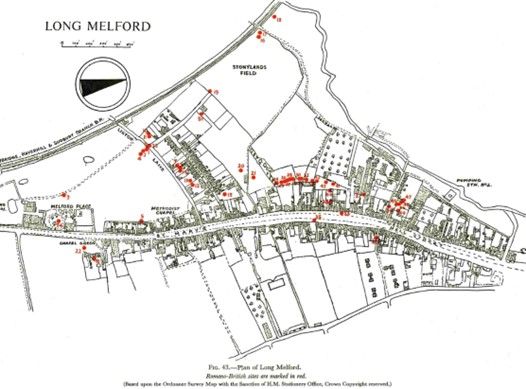
Map showing the location of Roman finds in Long Melford in 1958-1960 from the article by Norman Smedley, Roman Long Melford: 1961 (suffolkinstitute.pdfsrv.co.uk) where more detail on the individual site finds can be found)
In the two years following the initial discovery of the villa, controlled archaeological excavation was not feasible but pottery and other objects were collected by members of the Ipswich Museum staff, Mr Byford and Mr Partridge, the latter assiduously collecting any of the many items taken into school by us his pupils, who were not always aware that our newly acquired ‘treasures’ were to be taken from us, having usually just taken them to school to show our friends! Three workmen involved in digging the sewerage trenches in the village- VG Golding, W Drury and B Cattermole- were singled out in the 1961 report for special mention for the help they gave in saving key finds.
As a 1950s schoolboy resident of St Catherine’s Road, it is fascinating now, all these years later, to be reminded, from the 1961 finds map shown above, of the flurry of excavating activity that took place in the back gardens of the houses as sewerage and gas main trenches were dug. The article reveals that many residents retained items found in their gardens – the Fords at no 21 and the Cooks at no 25 but others such as the Eldreds at no 23 and the Woodhouses at no 7 allowed their finds to be taken away. One of the new trench sites was in the playground of St Catherine’s School behind St Catherine’s Church where part of a Roman storage jar was found. Across St Catherine’s Road in the building yard of Clement Theobalds (where our father stored his BSA motor bike) a rubbish pit was discovered with second century Roman pottery pieces and a fourth century coin.
Behind our house and Peter Brent’s, where the Meeting Field housing estate now stands, (no. 20 on the map) pieces from storage jars, beakers and flagons were uncovered. In the 1950s this field was rarely cultivated and it was a great playground to all of us on St Catherine’s Road. Peter remembers scratching about in this field and uncovering three objects. (see below)
He recalls:
‘The first was a nice shard of Samian ware which was quite glossy on the outside and had figures of a horse, a flower and something else I couldn’t identify. It was curved triangular in shape with a thin rounded rim and looked like part of a nice bowl. The size was about 5-6cm on the rim edge and a little less on the downward edges. After washing it, the colour was still quite bright and an orangey-red with figures in about 1-2mm in relief. I liked this and was a bit reluctant to give this up to Mr Partridge!’
‘The second piece was grey in colour and quite coarse pottery with darker almost blackened marks towards the base which my mother and grandmother thought indicated a cooking vessel that had been placed in a fire. In size it was about 6-7cm on the rim and again a rather triangular piece culminating in a point about 6cm from the top.’
‘I also found some pieces of what I think were tessellated pavement. They were quite coarse and not coloured as in mosaic but had a flecked appearance of beige, brown etc. It had a square section about 2cm in each plan direction and about 4cm in depth. Most of us who had found something were a bit reluctant to hand it in at school but we did.’
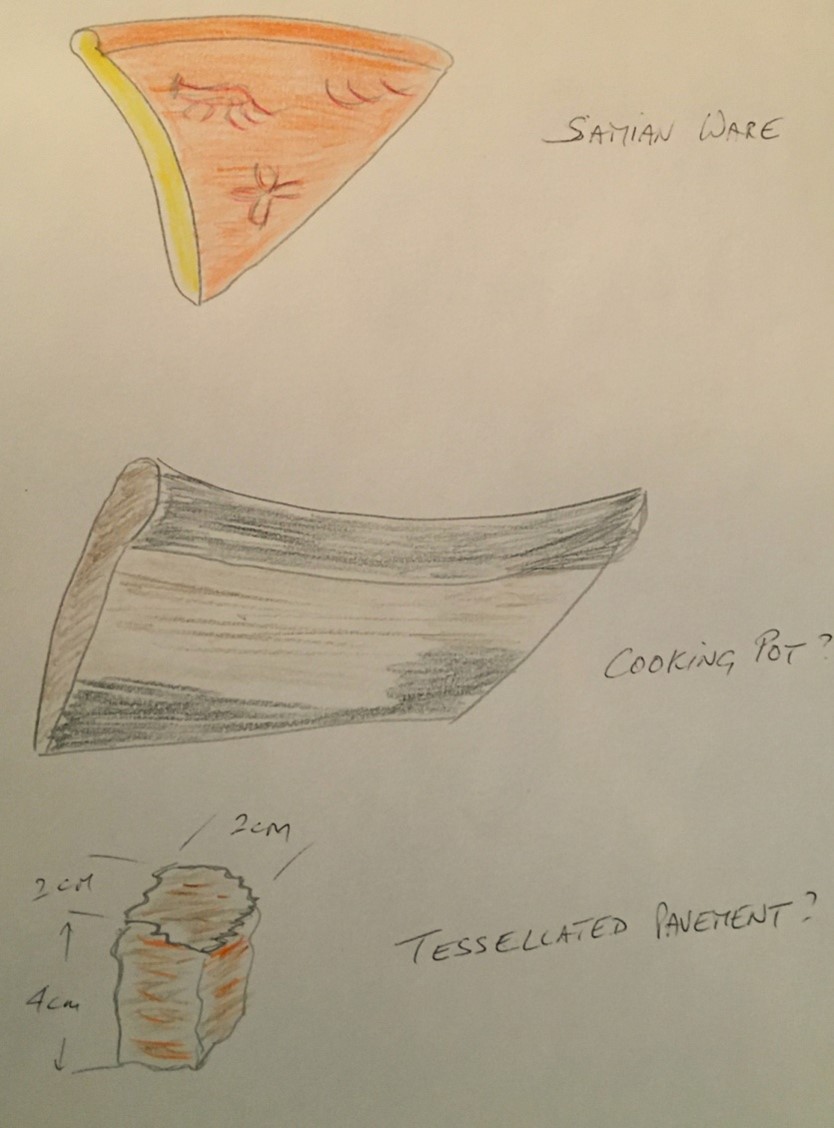
Peter Brent’s drawings of his Roman finds at Meeting Field in 1959-1960 Photo courtesy of Peter Brent
In our garden shed my dad, Bob Davies, kept an old tin stuffed full of WW2 items from his time in France, Belgium, Holland and Germany – Royal Artillery and Army Physical Training Corps cap badges, German badges, his sergeant stripes and some old bullets. Alongside all of this was a piece of Roman limestone paving that he had picked up from one of the neighbouring trenches –probably the same source where Peter Brent had made his finds! Boys being boys it was the WW2 items that were of greatest fascination to all of our friends – it was a bit more recent than the Romans!
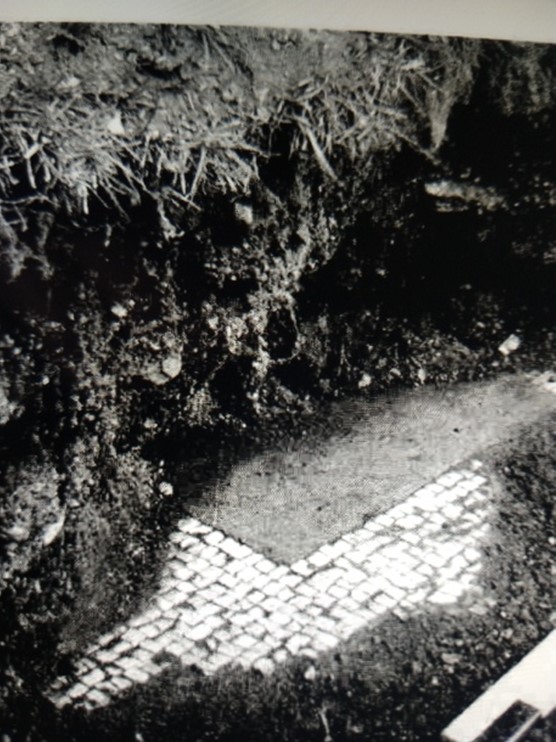
The Roman tessellated limestone paving in Cutler’s Park off Liston Lane that started it all off! Image taken from the article by Norman Smedley, Roman Long Melford: 1961 suffolkinstitute.pdfsrv.co.uk
Our village was emerging as an important Roman site and subsequent and more recent excavations have done much to show that Melford was not just a few scattered, isolated buildings but a small Roman settlement, close to important Roman roads, that was to grow into the village of today. From tiny acorns mighty oaks do grow!
John Davies February 2024
(Special thanks to Peter Brent for sharing his memories of his Roman finds)
